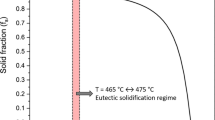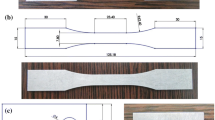Abstract
The relative influence of explosive and conventional forming on the terminal characteristics of a commercial precipitation-hardenable Al-4.5 pct Cu alloy (AA 2014) was investigated. This included the evaluation of microstructure, hardness, tensile properties, fatigue life, and response to heat treatment. Domes of 2014−0 and Alclad 2014−T6 were free-formed explosively with standoff into a 12-in. diam open die. Their isostatically formed counterparts were produced by rubber pressing. Specimens were sectioned from the domes, so that the material itself rather than components was characterized. The terminal behavior of both tempers was determined in the as-formed condition, and of T6 after forming in the 0 temper prior to the full heat treatment. It was found that the aforementioned properties do not depend significantly on the rate of forming. A simple method is presented for adjusting the forming strains mathematically so that it is not necessary to produce precisely equivalent prestrains experimentally before an adequate comparison of tensile properties can be made.
Similar content being viewed by others
References
R. N. Orava and H. E. Otto:J. Metals, February 1970, vol. 22, pp. 17–31.
G. S. Whiting and R. N. Orava: Phase Report, Center for High Energy Forming, University of Denver, October 1969.
R. N. Orava and H. E. Otto: Proc.2nd Int. Conf of the Center for High Energy Forming, University of Denver, 1969, pp. 1.2.1–33.
R. Mikesell, source cited in Ref. 3, Proc.2nd Int. Conf. of the Center for High Energy Forming, University of Denver, 1969, pp. 1.3.1–7.
G. S. Whiting and R. N. Orava, source cited in Ref. 3, Proc.2nd Int. Conf. of the Center for High Energy Forming, University of Denver, 1969. pp. 2.4.1–20.
A. A. Ezra:J. Mater., 1969, vol. 4, pp. 338–55.
S. Kulkarni and M. Kaplan, University of Denver, private communication, 1970.
J. D. Lubahn and R. F. Felgar:Plasticity and Creep of Metals, p. 286, John Wiley and Sons, Inc, N. Y., 1961.
P. D'Aguanno and G. Pfanner: Theoretical and Experimental Evaluation of High Energy Rate Forming of Hemispherical Shapes in Metals, Republic Aviation Corp., Rept. No. RAC 1893, NASA Phase II Rept., 1963; N66-23706.
M. G. Natrella:Experimental Statistics, NBS Handbook 91, National Bureau of Standards, Washington, D. C., 1966.
I. K. Sheffield and K. R. Agricola: Development of Explosive Forming Techniques for Saturn V Components, Martin Co., Rept., No. CR-66-6, January 1966; N66-18408.
J. T. Snyder,et al.: Explosive Forming of 2219 Aluminum, Martin Co., Rept. No. CR-65-41, 1965.
C. P. Bennett:Mater. Res. Std., 1967, vol. 7, pp. 305–9.
R. N. Orava and H. E. Otto:Mater. Res. Std., 1968, vol. 8, no. 4, p. 45.
C. P. Bennett: University of Winnipeg, Manitoba, Canada, private communication, 1969.
B. Eftestol,et al.: High Energy Rate Working of Metals, Proc. NATO Advanced Study Institute, Central Institute for Industrial Research, Osio, Norway, September 1964, pp. 296–311.
Author information
Authors and Affiliations
Additional information
R. MIKESELL, formerly Research Metallurgist, Metallurgy and Materials Science Division, Denver Research Institute, University of Denver.
Rights and permissions
About this article
Cite this article
Orava, R.N., Otto, H.E. & Mikesell, R. Tensile and fatigue properties of explosively and conventionally formed 2014 aluminum alloy. Metall Trans 2, 1675–1682 (1971). https://doi.org/10.1007/BF02913893
Received:
Issue Date:
DOI: https://doi.org/10.1007/BF02913893




